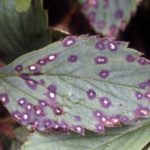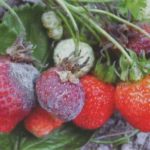In order for the strawberry to enjoy its tasty and fragrant fruits a little longer, it is necessary to choose varieties for planting with different ripening terms. The latest type of plant is Malvina. It begins to bear fruit from the end of June and almost until the second half of July, when other varieties no longer bear berries. A detailed description and features of the cultivation of this variety can be found below.
Table of contents
Inference history
Malvina Strawberry is one of the new varieties bred by German breeder P. Stoppell in 2010. The plant is obtained by hybridizing clone Sophie with Schimmelpfeng.
Malvina variety description
The size of the bush strawberry Malvina is 50 cm in diameter and 40-50 cm tall. Berries bring 1 time per season and is considered a kind of short daylight. Perfectly withstands transportation. Possesses high commodity properties.
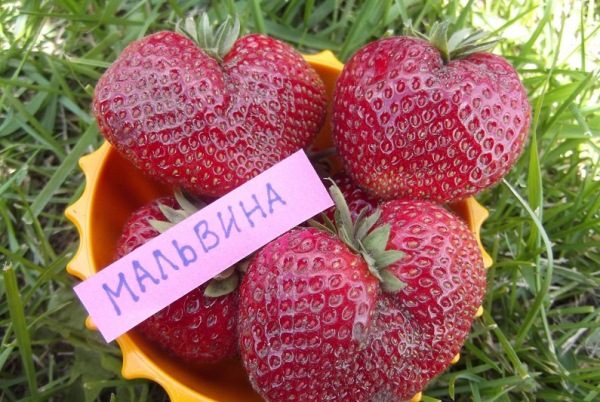
Flowering and ovary begins in early June. The yield is average, slightly lower than that of other plant varieties. With one bush you can get up to 1 kg of strawberries.
The Malvina variety has the following distinctive features:
- brilliant sheet large enoughgreen color;
- low inclined to the soil, it allows moisture to remain longer;
- not requiring pollination, flowers self-pollinating, large, are under the leaves (due to this placement, the fruit does not burn at all from the sun's rays);
- the berries themselves are scarlet, bulky, by weight 40-45 g; at the end of ripening become dark red;
- the flesh is not very firmbut dense, rich and sweet;
- multi-bush - at the beginning of summer, 7–9 flowering horns appear, about 6 flowers each;
- culture creates a lot of antennaethat facilitates reproduction.
Even not at full maturity, Malvina strawberries are very tasty. She is not afraid of rain or sun, she instantly blushes. Hardy, even under not very favorable conditions.
The advantages and disadvantages of the variety
The main advantage of this variety are the late dates of fruiting.
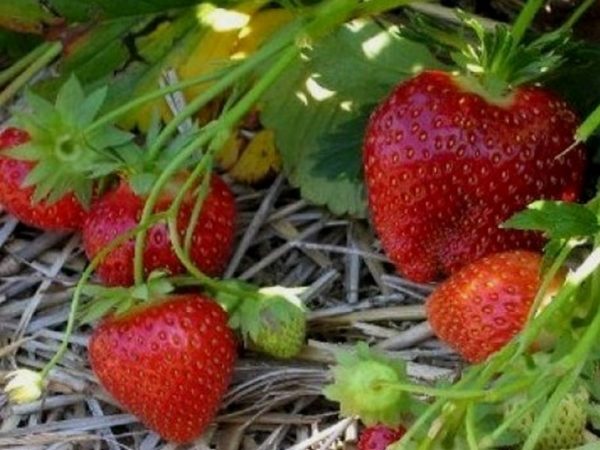
In addition, there are other advantages of strawberries:
- due to the high availability of sugar, berry has an amazing taste quality;
- the ability to transport culture over long distances;
- excellent presentation of the cropthat is very important when selling (if you keep it in a cool place, it will look good for a few days);
- it takes root well in wet climates, frequent rains do not affect the quality and taste of the fruit; heat and heat also have no effect on culture.
In addition to the positive qualities, strawberry "Malvina" has several disadvantages:
- since the bushes of the plant are quite large, plant them stands at a distancethat is not very practical in the presence of a small infield;
- fruit productivity 10-20% less exemplary.
Planting strawberries: the selection of places and dates
The right choice of location, the fulfillment of all the required agrotechnics in the cultivation of Malvina strawberries, as well as the timely planting of plants guarantee an excellent harvest.
Location selection
- A suitable place for seedlings will be straight surface areawhere there are no drafts and weeds.
- Garden strawberries are not very whimsical to the soil, but it is better to plant it all the same on light fertile lands.
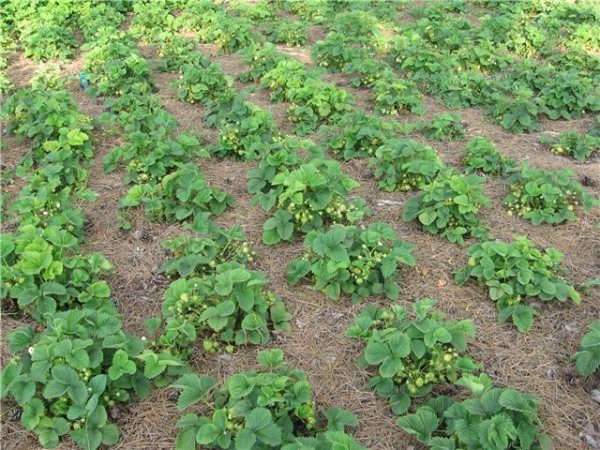
For planting the plant is well suited the second half of August or the first of September. Before this follows prepare the beds, dig them in 25-30 see deep (about a month).
Landing pattern
It is better to choose saplings strong, with the developed socket. Strawberry roots should have a strong lobe. Planted preferably in rows.Larger bushes need more space and light.
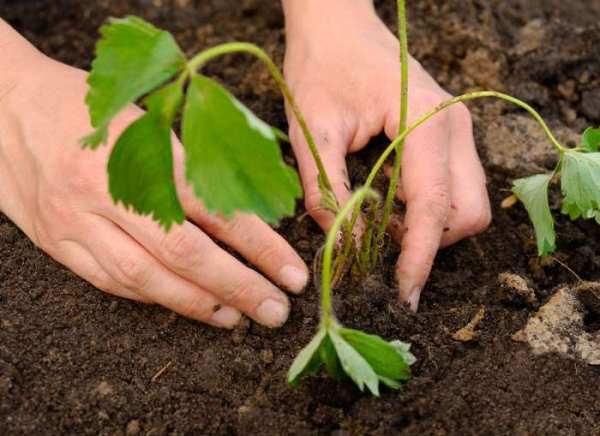
Before planting in the hole you need to pour water. When it is absorbed, gently inject the seedlings, correct the roots, fill with earth and press down slightly. Then re-watered the seedling, but not at the very root, but near it. Then watering is done 2 times a day until the plant is rooted. As a rule, Malvina strawberries quickly adapt to a new place.
How often to water the culture?
The plant needs to perform a special water regime. During growing, ripening and fruiting need constant, abundant watering.. If the moisture is small, then the fruits will be small and even with bitterness.
Top dressing bushes

Plant nutrition is good to produce in 3 stages:
- At the very beginning of growth. It should be fertilized with nitrogen, it will help to form berries. Can be mixed for 1m2 the ground 10 grams of urea, 1:10 cow humus and about 1:50 bird droppings diluted in water.
- During flowering. At 1 m2 soil add 20 g of mineral fertilizers with the presence of potassium, phosphorus, nitrogen.
- After harvesting. For the formation of strong fruit buds, you should make another feeding without the use of nitrogen. For this you will need for 1 m2 soil 20 g of sodium chloride (can be replaced by superphosphate).
Before planting Malvina, it is possible to add organic fertilizers (for 5 m2. land - 2 buckets of humus).
Fight against diseases and pests
Diseases
Malvina variety is different excellent resistance to some diseasesfor example, verticillary drying or powdery mildew. Occasionally infected with brown spot.
Mostly strawberries are damaged by gray mold.which may occur in cool, wet weather. Fruits become soft with color gray from decay. During rains, experts recommend for preventive purposes of the disease, sprinkle sawdust between rows.
- Strawberries hit by brown spot
- When ripe, strawberries may be affected by gray mold.
Preventive actions:
- before flowering row is treated with copper oxychloride; on 10 l of water add 1 tbsp. l component; put on 1 m2 - 1 liter of solution;
- at the end of fruiting it is desirable to re-treat the site; on 1 bucket of water put 2 tbsp. l oxychloride copper, here is a little bit of liquid soap.
When it was not possible to get rid of gray rot, the affected berries are destroyed.
Pests
Extremely rarely strawberries are attacked by Malvina: weevils, thrips.
To protect the culture:
- from weevil, strawberries before planting, during the appearance of flowers and after harvest, should be treated with the insecticide "Aktara";
- from thrips, also at the same time, spray the means "Aktara", "Aktofit", "Aktellik" and others.
For the purpose of prevention between rows plant odorous crops (red pepper, garlic) or sprinkle strawberries with infusions of these plants.
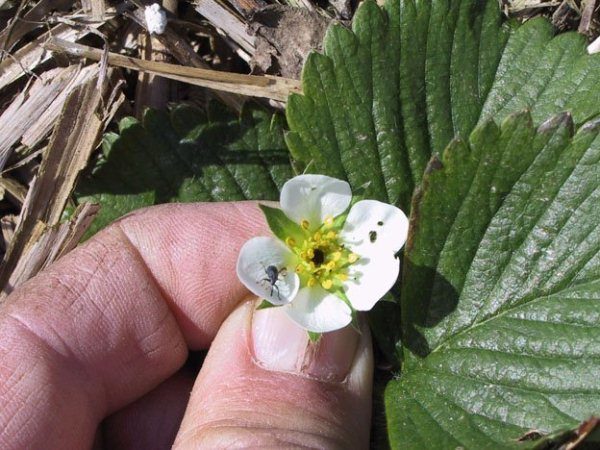
When various pests appear, carefully remove all the bad parts so that their larvae do not further multiply.
Preparing for the winter
This variety has a good winter hardiness - maintains t -19°WITH. But in areas with fierce winters, it is still necessary to wrap strawberry beds with hay or straw.
Strawberry Malvina in grooming and planting is no different from other varieties. The only drawback is considered low in comparison with the reference types of yield. However, the excellent taste properties compensate for this.

